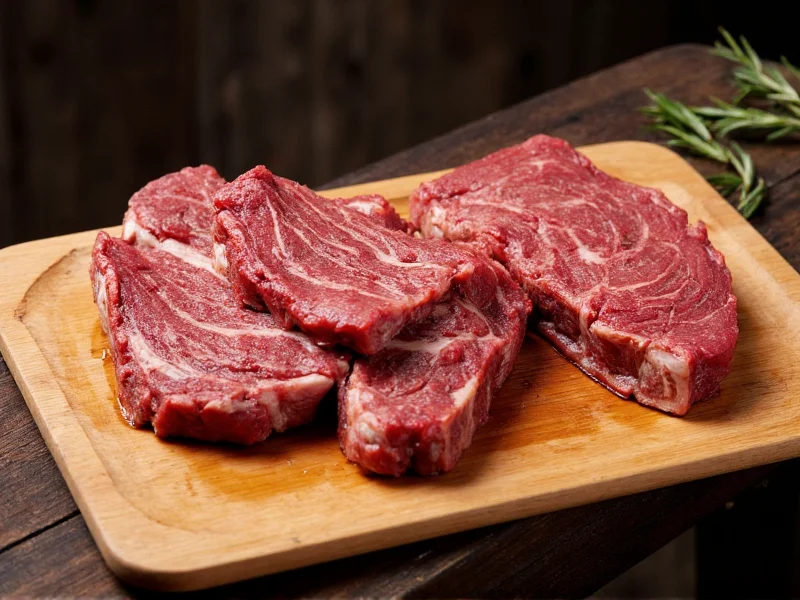The fundamental difference between short ribs and ribs is their anatomical origin: short ribs come from the plate section (lower chest area) of the animal and contain multiple small bone segments with substantial meat between them, while traditional "ribs" (like back ribs or spare ribs) come from the rib section along the spine and feature longer, continuous bones with less meat between them.
Anatomical Origins: Where These Cuts Come From
Understanding the difference between short ribs and ribs starts with their location on the animal. Short ribs are harvested from the plate section (also called the belly or lower chest), specifically from ribs six through ten. This area works harder during the animal's life, resulting in more connective tissue and richer flavor.
Traditional ribs—whether back ribs or spare ribs—come from the rib section along the spine. Back ribs (also called loin ribs) come from where the rib meets the spine after the ribeye steak is removed, while spare ribs come from the belly side of the same rib section.
Physical Characteristics Comparison
The visual and structural differences between these cuts are significant:
| Characteristic | Short Ribs | Traditional Ribs |
|---|---|---|
| Bone Structure | Multiple short bone segments (2-6 inches), often cross-cut | Longer continuous bones (6-12 inches) |
| Meat-to-Bone Ratio | Higher meat content between bones | Less meat between bones, more on top |
| Fat Content | Higher marbling and external fat | Moderate marbling, less external fat |
| Connective Tissue | Abundant collagen requiring slow cooking | Less connective tissue, more tender |
Flavor and Texture Profile
Short ribs deliver a richer, beefier flavor profile due to their location on the animal and higher fat content. When cooked properly using low-and-slow methods, the abundant collagen transforms into gelatin, creating that signature fall-off-the-bone tenderness with unctuous texture.
Traditional ribs (back ribs or spare ribs) offer a leaner profile with more straightforward meat flavor. Back ribs are the most tender option with moderate fat, while spare ribs contain more fat and connective tissue. Both benefit from slower cooking than typical steaks but don't require the extended cooking times that short ribs demand.
Cooking Methods and Best Practices
The cooking approach for these cuts differs substantially due to their structural composition:
Short Ribs Preparation
Short ribs absolutely require slow, moist-heat cooking methods to break down their substantial connective tissue. Ideal techniques include:
- Braising at 275-325°F for 2.5-4 hours until fork-tender
- Slow cooking in a crockpot for 8-10 hours
- Smoking at 225°F for 6+ hours (often wrapped in foil after 3 hours)
Popular short rib dishes include Korean galbi, beef bourguignon, and braised short ribs with red wine sauce. The "English cut" (parallel to the bone) works best for braising, while the "flanken cut" (across the bone) is ideal for quicker grilling.
Traditional Ribs Preparation
Traditional ribs respond well to both dry-heat and moist-heat methods:
- Back ribs: Can be grilled, smoked, or roasted (250-275°F for 4-6 hours)
- Spare ribs: Best smoked low and slow (225°F for 5-7 hours), often with the membrane removed
- Both can be finished with barbecue sauce or dry rubs
Unlike short ribs, traditional ribs maintain some structural integrity after cooking and are typically eaten by hand.
Pricing and Availability Considerations
Short ribs generally command a higher price per pound than traditional ribs due to their substantial meat content and growing popularity in gourmet cooking. At most supermarkets, you'll find:
- Short ribs: $8-14 per pound (higher at specialty butcher shops)
- Back ribs: $4-8 per pound
- Spare ribs: $3-6 per pound
Availability varies by season and region. Short ribs have become more widely available in recent years due to Korean and Latin American culinary influences, while traditional ribs remain consistently available year-round.
Substitution Guide: When to Use Which Cut
While these cuts aren't perfectly interchangeable, understanding substitution possibilities helps when planning meals:
- Use short ribs when you need substantial meat portions for braising dishes
- Choose traditional ribs for barbecue-focused recipes where presentation matters
- Short ribs can substitute for chuck roast in braises (adjust cooking time)
- Traditional ribs cannot effectively substitute for short ribs in most recipes due to lower meat content
- For Korean BBQ, short ribs (galbi) are essential—substituting traditional ribs would create a completely different dish
Shopping Tips for Both Cuts
When selecting either cut, look for:
- Bright red meat with creamy white fat (avoid grayish meat or yellow fat)
- Good marbling throughout the meat portion
- Fresh, clean smell (no sour or ammonia odors)
- For short ribs: Even thickness across the cut for consistent cooking
- For traditional ribs: Intact membrane on spare ribs if you prefer to remove it yourself
Consider bone-in versus boneless options—bone-in generally provides better flavor during cooking, while boneless offers convenience for certain recipes.
Conclusion: Making the Right Choice for Your Meal
Understanding the distinction between short ribs vs ribs helps you select the perfect cut for your culinary goals. Short ribs deliver maximum meat content and rich flavor ideal for slow-cooked comfort food, while traditional ribs offer the classic barbecue experience with that finger-licking quality. Consider your cooking method, time constraints, and desired end result when choosing between these two excellent beef options.











 浙公网安备
33010002000092号
浙公网安备
33010002000092号 浙B2-20120091-4
浙B2-20120091-4